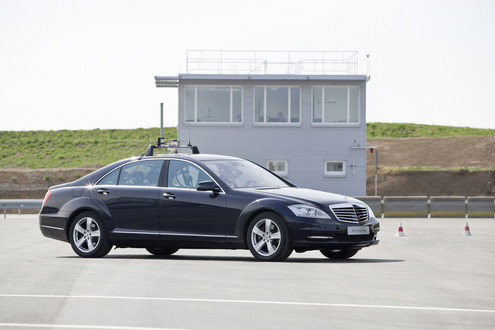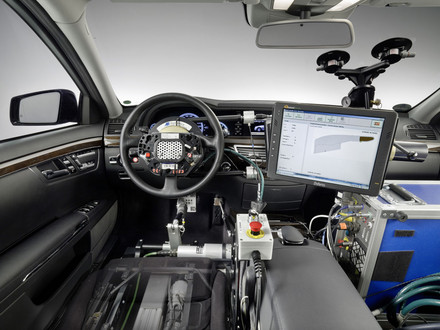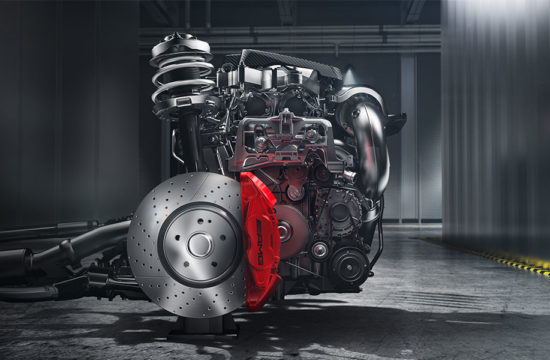
As the company that always come up with new and innovative technologies, Mercedes is now working on an ambitious project regarding autonomous driving. The goal here is not making your car automated, they are just developing this system for testing purposes. This way their test drivers and engineers won’t have to risk their lives doing all those dangerous maneuvers evaluating every new model!
Moreover, a computer can do a certain test much more precisely than the best of the test drivers, so the result are more accurate. Of course this systems can be used to develop an autopilot system for production cars, but it just does not make sense!
Because even though a sophisticated autopilot can do the job of driving the machine, would you ever get on an autonomous plane with no human pilot onboard?! It’s the same with automobiles.
Details on Mercedes automated driving techniques here:

Autopilots ensure greater precision and relieve development engineers
In addition to established methods, Mercedes-Benz will in future fulfil requirements for reliable functionality and operational safety in future assistance systems through the “automated driving” of test manoeuvres on dedicated proving grounds. Prototypes used for this purpose are series production vehicles equipped with “robots” for steering, acceleration and braking. An on-board computer controls the autopilot so that a pre-programmed course is followed exactly – even if several vehicles are involved in one manoeuvre.
Test engineers in the control centre monitor all events and can stop the vehicles at any time. In parallel, the vehicles perform self checks and brake automatically if they register discrepancies. Thus, the test configuration is safe yet flexible. All Mercedes-Benz models can be equipped with the technical equipment for “automated driving”. Moreover, a variety of different safety systems and equipment can be tested.
Using “automated driving”, engineers analyse safety innovations under real-life conditions in the vehicle, addressing two critical challenges:
* Reproducibility. In order to calibrate the systems exactly, the same tests must be varied and repeated extensively. In so doing, all parameters like vehicle distances, speeds and steering radii must be exactly to specifications and always precisely maintained in order to guarantee comparability.
* Safety. Because the systems are intended to kick in only in critical situations, such scenarios must be induced during testing. The manoeuvres demand precision timing and cannot be permitted to put anyone in danger.Both cases place human beings at their limits – in terms of their ability to react and the issue of reproducibility. However, for complex electronic systems and for assistance systems in particular, fully comprehensive functional validation must be carried out in a manner that is as close to reality as possible, thus making this kind of test driving indispensible.
The precise repeatability of the test methodology enables test vehicles to maintain exactly the pre-determined speed and course and to brake very precisely. For example, if a vehicle drives a pre-planned course several times, the tracks of all the runs vary from one another by less than two centimetres. Should the vehicle be brought to a complete halt at a particular location, the end points of all braking manoeuvres are within a radius of three centimetres.
Alongside the proving of assistance systems, “automated driving” will also be used in extreme tests in future. These put the vehicle under loads that are well in excess of those reached under normal use in traffic. The intention is to ascertain, for instance, that airbags are not activated unintentionally should the car be driven heavily over a ramp or against a kerb. Test drives that involve a high degree of physical stress for the driver can thus be avoided.
State-of-the-art test methods for the highest safety demands
In their development work, Mercedes-Benz engineers use the results from the company’s in-house accident research, which delivers important findings. A variety of networked validation methods guarantee that the systems function reliably at the critical moment. Company philosophy insists that validation must go considerably farther than prescribed by regulatory standards. When it comes to passive safety, the internal company crash test requirements go well beyond meeting standard crash test requirements. The combination of computer simulations and real-life crash tests ensures passive safety to Mercedes-Benz standards.
Mercedes-Benz also makes use of state-of-the-art, networked test methods when it comes to active safety. Drive simulator tests combined with simulation procedures deliver a faster and more precise development process and complement test drives under real-life conditions.
“In Sindelfingen, we are currently building a new drive simulator. The state-of-the art technology of this equipment will make the future development of new safety systems even faster and more precise,” confirms Balasubramanian.
Automated driving as the basis of future innovations
Mercedes-Benz is the only vehicle maker in the world to use “automated driving” as an additional element in the testing process. It will be used on dedicated proving grounds in tests that would be virtually impossible to reproduce manually, like merging at different speeds and distances; high-risk tests where, for example, a vehicle brakes heavily in front of another that swerves at the last minute; and safety-critical tests whereby, at an intersection, one vehicle crosses just in front of or behind the path of a second vehicle.
With “automated driving”, Mercedes-Benz has developed a new, unique testing method for safety systems. It is yet further proof of the innovative power of Mercedes-Benz. The new test method guarantees the fast and efficient development of assistance systems to the highest levels of quality and reliability and also offers maximum safety at work for employees.
Bharat Balasubramanian sums up: “In order to be able to set trends in the field of safety in future, too, our test procedures must be able to keep pace with the wealth of ideas generated by our engineers. With automated driving, we feel we are well equipped for the development of the next generation of assistance systems.”









Automated driving will be the most powerful tool in driving industry as well as the driving test improvements. Creating security measures and innovations that would be in benefit for an accurate and efficient road access is the best deal ever created to manipulate driving success.